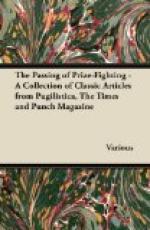There is no telling how this unhappy difference will terminate; for though at present matters appear tolerably quiet, we know not (as in the case of the Canadas) at what moment we may have to inform our readers that
[Illustration: THE BORDERS ARE IN A FLAME.]
* * * * *
GEOLOGY OF SOCIETY.
SECTION II.
We last week described the different strata of society comprehended in the INFERIOR SERIES, and the lower portion of the Clapham Group. We now beg to call the attention of our readers to a most important division in the next great formation—which has been termed the TRANSITION CLASS—because the individuals composing it are in a gradual state of elevation, and have a tendency to mix with the superior strata. By referring to the scale which we gave in our first section, it will be seen that the lowest layer in this class is formed by the people who keep shops and one-horse “shays,” and go to Ramsgate for three weeks in the dog-days. They all exhibit evidences of having been thrown up from a low to a high level. The elevating causes are numerous, but the most remarkable are those which arise from the action of unexpected legacies. Lotteries were formerly the cause of remarkable elevations; and speculation in the funds may be still considered as amongst the elevating causes, though their effect is frequently to cause a sudden sinking. Lying immediately above the “shop and shay” people, we find the old substantial merchant, who every day precisely as the clock strikes ten is in the act of hanging up his hat in his little back counting-house in Fenchurch-street. His private house, however, is at Brixton-hill, where the gentility of the family is supported by his wife, two daughters, a piano, and a servant in livery. The best and finest specimens of this strata are susceptible of a slight polish; they are found very useful in the construction of joint stock banks, railroads, and other speculations where a good foundation is required. We now come to the Russell-square group, which comprehends all those people who “live private,” and aim at being thought fashionable and independent. Many individuals of this group are nevertheless supposed by many to be privately connected with some trading concern in the City. It is a distinguishing characteristic of the second layer in this group to have a tendency to give dinners to the superior series, while the specimens of the upper stratum are always found in close proximity to a carriage. Family descent, which is a marked peculiarity of the SUPERIOR CLASS, is rarely to be met with in the Russell-square group. The fossil animals which exist in this group are not numerous: they are for the most part decayed barristers and superannuated doctors. Of the ST. JAMES’S SERIES it is sufficient to say that it consists of four strata, of which the superior specimens are usually found attached to coronets.




